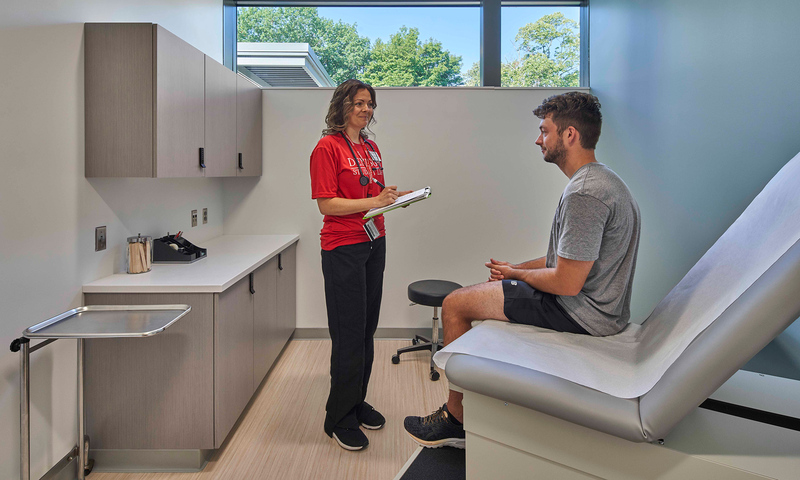May is Lyme Disease Awareness Month. Here are some tips and information to help you avoid this disease.
Licking County has been identified as a county which is “Lyme Disease endemic,” meaning that two or more cases of Lyme Disease have been confirmed. The presence of confirming cases of Lyme Disease is felt to be due to an increase in the black-legged tick (deer tick) population in Ohio.
You are more likely to get Lyme Disease if you live or spend time in grassy and heavily wooded area where ticks carrying the disease thrive. It is important to take precautions in areas where ticks could be prevalent.
Signs and Symptoms
Lyme Disease signs and symptoms are variable (can be different for different people) and usually appear in stages. Lyme Disease is a multisystem disorder caused by a spirochete through a tick bite. Tick bites usually occur in the summer months but can happen anytime between April through November.
First or Early signs and symptoms of Lyme Disease:
1-4 weeks after being infected by a tick
- An expanding, circular red rash, with Bull’s-eye appearance (unfortunately not everyone develops this rash).
- Flu like symptoms of fatigue, tiredness, joint and muscle pain, headache or stiff neck
- Later signs and symptoms of Lyme Disease
Weeks to months following the initial infection
- An expanding, circular red rash appearing in other areas of the body
- Joint pain and swelling, especially likely to affect your knees
- Neurological problems
Prevention
The best way to prevent Lyme disease (as well as Rocky Mountain spotted fever and other tick-borne infections), is to reduce your chance of exposure to ticks by avoiding areas where deer ticks live, especially wooded, bushy areas with long grass.
CDC’s guidelines listed below will further reduce your chances of getting Lyme Disease
- Avoid Direct Contact with Ticks
- Avoid wooded and brushy areas with high grass and leaf litter.
- Walk in the center of trails.
- Repel Ticks with DEET or Permethrin
- Use repellents that contain 20 to 30% DEET on exposed skin and clothing for protection that lasts up to several hours. Always follow product instructions.
- Use products that contain permethrin on clothing. Treat clothing and gear, such as boots, pants, socks and tents with products containing 0.5% permethrin. It remains protective through several washings. Pre-treated clothing is available and may provide longer-lasting protection..
- Find and Remove Ticks from Your Body
- Bathe or shower as soon as possible after coming indoors (preferably within 2 hours) to wash off and more easily find ticks that are crawling on you.
- Conduct a full-body tick check using a hand-held or full-length mirror to view all parts of your body upon return from tick-infested areas.
- Examine gear and pets. Ticks can ride into the home on clothing and pets, then attach to a person later, so carefully examine pets, coats, and day packs.
- Tumble clothes in a dryer on high heat for an hour to kill remaining ticks. (Some research suggests that shorter drying times may also be effective, particularly if the clothing is not wet.)
If You Find a Tick on You
Here is a helpful link from the CDC which explains how to effectively remove a tick should one become attached to your skin.
If you develop a rash or fever within several weeks of removing a tick, see your medical provider and be sure to mention your recent tick bite, when it occurred and where you most likely were at the time of the tick bite.
Ticks are only able to transmit disease if they are attached to the host (you) for a significant period of time (several hours at a minimum). Therefore, finding ticks early and removing them before they are attached or shortly after this occurs should significantly decrease the chance of infection. Unfortunately, the deer ticks are quite a bit smaller than the dog ticks with which most of us here in Ohio are familiar. This makes them much more difficult to detect, even when they have become attached and engorged.
Fortunately, the treatment for Lyme disease diagnosed in the early stages is quite effective, safe, and inexpensive, consisting typically of treatment with an oral antibiotic. When the symptoms have been present for a longer period of time, treatment can be more challenging but is still usually effective.
As you may recall, we communicated with the campus community just prior to spring break regarding prevention of mosquito borne illnesses. You might recognize that the recommendations for use of insect repellents and protective clothing are identical for both mosquito- and tick-borne illnesses. In both cases, “an ounce of prevention is worth a pound of cure”. And of course, if you have any questions about these illnesses or possible exposure, but please contact the Whisler Center for Student Wellness at 740-587-6200.
